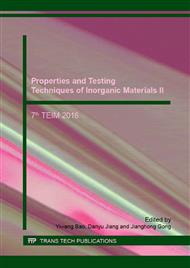p.137
p.143
p.148
p.153
p.159
p.164
p.169
p.174
p.179
Boron Carbide Hollow Microspheres Prepared by Polymer Derived Method
Abstract:
Polycarborane, as a kind of boron carbide polymeric precursor, was synthesized by hydroboration reaction with styrene, divinylbenzene as the carbon resource and borane as the boron resource in this work. The polymer precursor which had good solubility and film-forming ability was soluble in most organic solvents. Furthermore, polycarborane was used to fabricate hollow polymer microspheres by emulsion technique. The compact boron carbide ceramic hollow microspheres were prepared by ceramization of the polymer microspheres. Ceramic microspheres with diameters ranging from 1 to 1.5 mm and shell thicknesses from 15 to 30 μm were easily prepared by changing emulsion composition and curing conditions. Micrographs of SEM showed that the hollow microspheres had smooth surface and good sphericity. These boron carbide ceramic hollow microspheres are of significant importance for application in the field of neutron moderator in nuclear reactors, power generation in deep space flight, etc.
Info:
Periodical:
Pages:
159-163
Citation:
Online since:
January 2017
Authors:
Keywords:
Price:
Сopyright:
© 2017 Trans Tech Publications Ltd. All Rights Reserved
Share:
Citation:


